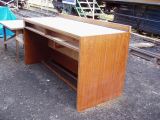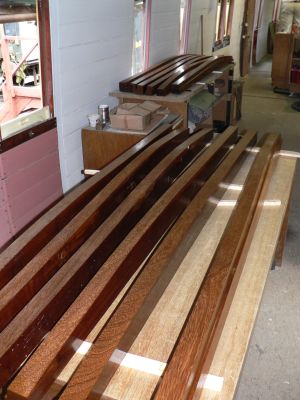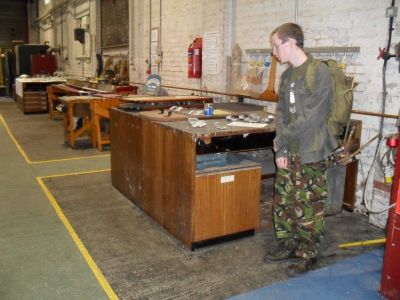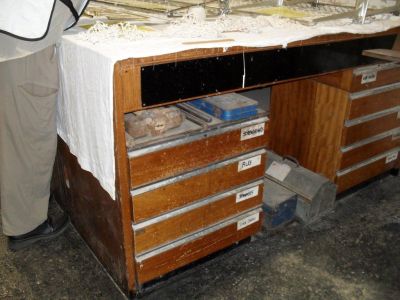Armchair members do get involved!
I've been riding on the SVR from the days of "Day Membership" having become a member
in 1982. Then family commitments limited visits a little until my son could ride
with me regularly on most galas. In 2004 during members day whilst at Bewdley, I
visited the LNER Coach Fund and talked to Richard Gunning & Mike Cranmore who were
doing up "2701". Having seen the type of wood used in the coach restoration, I enquired
if they might want a few wooden benches that my employer (The University of Birmingham)
was disposing of as part of a refurbishment of the teaching lab's (I'd seen a previous
lab's benches being "skipped"). I was asked if I could bring along a sample, which
I did. It turned out to be "Iroko". Then things changed, it wasn't going to be just
a few benches from one lab. It turned out, due to a government grant, we were going
to refit five yes FIVE labs (some had up to 60 positions). So I asked the "powers
that be" whether the SVR could have any of the wood. They were
somewhat surprised.
But, when they realised that they would get the credit for the recycling of the timber
(via the LNER Coach Fund's website) and not have to hire in several skips, I was
told that I could dismantle the benches during my lunch breaks, but NOT in the firm's
time. (I was told I'd got six
weeks before the builders were due to arrive).
I duly
advised Richard of the facts. He came in to see exactly what was on offer and was
pleasantly surprised with the benches. He said he'd try to arrange some transport
from the SVR to collect a complete bench or two for the LNER Coach Fund's workshop.
He duly arrived with Hugh McQuade who, when shown around, asked if a set of four
"single depth" benches still untouched at the end of one of the labs might be available
(at the time these had a live gas supply to them) it was
arranged with a friend in
the University's maintenance department (who'd visited the railway on the diner service)
to "sort the problem".
The benches were removed the next week with Hugh & Richard,
and they then made their way to Kidderminster for installation in the North Star
works. Then as the piles of dismantled benches began to grow in the car park at work,
there began a weekly, sometimes almost daily collection of wood by members of the
LNER Coach Fund. Both Tom Root's & Richard's cars were to be seen well loaded.
As
the deadline to clear the labs approached, it became obvious that I was not going
to be able to extract all of the wood during just my lunch breaks so, my boss formally
"told me to remove the benches". I then had two weeks of solid bench dismantling,
although demolition is probably a more accurate description, as some of it was none
too subtle (dropping over a hundred weight of Iroko & beech to spring the joints)
certainly woke a few people up. My son (an SVR junior member) was also involved in
this, as his work experience rather fortuitously coincided!
Several colleagues also
"dropped in" to see what was happening. It must have been the bench nearly falling
in to their offices below, and they were awarded either a screwdriver or crow bar,
Thanks Lad's!
That was the end of the wood supplies, or so I thought, when in May
2006 we had been advised of a new grant to refurbish the rest of the labs in the
building. Having talked nicely to my boss (and his boss) I asked if there was any
way that the remaining pieces of "hardwood" could be got out during the works. However
this time I couldn't do the removal. But again having the pictures of the
first benches'
removal and subsequent re-use on the LNER Fund's website paid dividends, as the contractor
agreed to place ALL of the hardwood removed in the car park prior to it's being "skipped".
Several large pieces of Iroko up to 12' long,18" wide by 2" thick plus several "heavyweight"
benches 2' wide, 8' long by 3" thick also appeared ready for collection. So ended
the 2006 season of timber reclamation.
Then quite out of the blue in May 2007, I was
asked if the SVR might be interested in a few benches in a neighbouring department
as word of my "scrounging" timber had evidently spread. Yes there were four labs
to be cleared, and this time the refurbishment contract specifically stated that
the "LNER Coach Fund" could have the timber if they wanted it. (My Employer's definitely
going "Green"). So after a couple of Emails and the odd phone call, Tom & Mike arrived
to look over our latest "acquisitions". A brief chat with the builders enabled the
safe removal & temporary storage ready for Mike & Tom to arrive with a large trailer
(normally on Friday lunchtimes) so we could
load our "treasure" ready for its delivery
to Kidderminster.
Having read in the SVR magazine the various articles on the restorations
of several coaches, every time that "Iroko" is mentioned, I have a shrewd idea of
where it came from.
So I'll ask the question – can an "armchair" member help in restoring
the railway's stock?
I believe the answer is "Yes you can".
Even through the last few
months when the railway has been fragmented, I've still managed to acquire more timber
to keep stocks up ready for the next restoration, I may even become an active member.
Alan
Yates
February 2008
An Armchair Member (The next instalment)
Following on from the original “Acquisitions“ in 2004 – 2006, I have continued to
visit the coaches in Bewdley yard to see the progress, often ending up holding something
up for one of the restoration team whilst asking what wood to keep an eye open for.
(The family know where I’ve disappeared to). I’d also obtained about 20 pieces of
Iroko (6’ x 1’) intended for shelving in my garage, but these were donated to the
cause, turning up in the car park at Bewdley on Sunday morning with the family to
unload them caught the team by surprise, they were soon looking for “secure“ storage
to stop other groups “borrowing them“. Then, as luck would have it, my employers
started on the refurbishment of two more locations, one of which I unfortunately
lost out on. (I later found out the wood “planks“
turned out to be block construction
anyway). The other location was the building adjoining my workplace, this time a
chat with the builders came up trumps, as they actually dismantled the wood partitions
and cladding for me (none of this ‘lunch-times & tea-breaks’), the resulting pile
of timber (Iroko & Sapele) was photographed and details emailed out to the stalwarts
of the LNER Coach Fund (Richard Gunning & Mike Cranmore). The response was the usual
“when can we come?“ Arrangements were made with my employers regarding its collection,
our security staff now
just raise the barrier without any questions as they visit
us so often. (I do tell them they will be coming sometime this week……… ). During
my visit on the “Behind the Scenes” weekend I finally got to see the benches that
Hugh McQuade had asked for to put in the “North Star works“ at Kidderminster from
his visit in 2006, taking the obligatory pictures to prove they’d been used as intended.
(Hugh, the Iroko you mentioned in your last SVR article came from Birmingham University
not Aston!) With all of this information gathered, I decided to make an approach
to my employers (The University of Birmingham) regarding an acknowledgement on the
LNER Coach Fund’s website
together with a reciprocal arrangement with the builders.
Just look at the website to see the results, the pictures of the wood pile inside
the building and of the loading of the timber at my workplace now feature on the
website. Having helped to move & load the timber with Richard & Mike, we estimated
that there was about 1.5 – 2 tons of wood on this latest episode (from the way the
trailer springs were bent). If you want to know what this is worth to the Fund, then
I suggest you look up the price of Iroko from your local timber merchant for four
of the 100 x 150 mm pieces which were 5 metres long. I found a price on the web for
a 4 metre length (the longest they do) at £117 each, just look at the website pictures
of Richard Gunning for the number of pieces there were.
So to answer the question
I posed in the original article back in 2008, do “Armchair” members help? Just look
at what one member has achieved! I know from reading the SVRA forum website other
“Armchair” members do their bit too.
Alan Yates
Oldbury, West Midlands
December 2010







